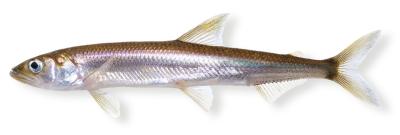Rainbow Smelt
Osmerus mordax
 Distribution: Rainbow smelt are native to Atlantic coastal drainages from Labrador south to New Jersey and Pacific coastal drainages in Canada and Alaska. Native freshwater populations exist in a number of inland lakes and ponds throughout the northeast. Rainbow smelt have been introduced to many waterbodies, most notably the Great Lakes, to provide forage for gamefish. In New Hampshire, they occur in coastal rivers as well as in many inland lakes and ponds.
Distribution: Rainbow smelt are native to Atlantic coastal drainages from Labrador south to New Jersey and Pacific coastal drainages in Canada and Alaska. Native freshwater populations exist in a number of inland lakes and ponds throughout the northeast. Rainbow smelt have been introduced to many waterbodies, most notably the Great Lakes, to provide forage for gamefish. In New Hampshire, they occur in coastal rivers as well as in many inland lakes and ponds.
Description: A slender and cylinder-shaped fish, they have an eye that seems disproportionately large for their head. They are predominately silver, with shades of purple, blue, and pink on the sides, with a white underside.
Species commonly confused with: Lake chub, creek chub, Atlantic silversides
Habitat: Smelt can be found in the mid-water column, where they travel in schools. In salt water, rainbow smelt are rarely found far from shore, although recent trawl surveys have encountered small schools of smelt as far as 60 km offshore in depths up to 77m. Patterns of movement are dependent on water temperature and change with the seasons. In the winter, smelt are caught by anglers through the ice on the Great Bay estuary as they move in and out with the tides in search of food. Smelt move into rivers and streams to spawn during the early spring. In freshwater lakes and ponds, spawning also takes place on gravel shoals.
Life History: Adult rainbow smelt spawn shortly after ice-out in the lower reaches of streams or along shorelines. Spawning takes place at night and lasts for several days. Coastal populations move into freshwater rivers to spawn at the first barrier above the head of tide. They prefer well oxygenated riffle habitat for spawning. Rainbow smelt are a short lived species, with most individuals reaching maturity in their second year. They rarely exceed 10 inches (250mm) in length. Smelt feed on marine worms, shrimp, and zooplankton. Under favorable conditions, smelt populations can become extremely abundant and provide an important source of forage for larger predators.
Origin: Native/Introduced
Conservation/Management: Rainbow smelt were once harvested by the barrel full in the 1800s for use as fertilizer, cattle feed, and later as a food source. Their numbers have experienced alarming declines in recent decades. Populations south of Massachusetts no longer appear viable, and in the north, a once thriving recreational winter smelt fishery is slowly fading into obscurity. Catch rates in Great Bay have declined significantly since the 1980s. A number of threats have been implicated in the decline. Access to spawning habitat has been reduced by dams and culverts at the head of tide. Spawning habitat has also been altered by stream bank modifications which can lead to changes in flow and sediment deposition. Increased nutrient loads in coastal rivers from fertilizer use and failed septic systems may cause excess algae to grow on smelt eggs, which effects there survival. Changes in ocean temperatures, the timing, and duration of ice formation in the estuaries, and shifts in Gulf of Maine fish communities may also play a role in the decline of smelt populations in the northeast. A regional conservation plan has been developed for Rainbow smelt in the Gulf of Maine with a focus on collecting the data needed to monitor the current population and get a better understanding for causes of its decline.
Rainbow smelt populations in New Hampshire’s freshwater lakes are a different story. They are carefully managed to support stocked landlocked salmon and trout fisheries. Most of these smelt populations were introduced or augmented with the intent of increasing the forage base. Acoustic surveys combined with trawl surveys and spawning smelt dip net surveys are used to collect data on the average size and estimated abundance of smelt in certain waterbodies. This data is considered when setting target stocking rates for salmon and rainbow trout



